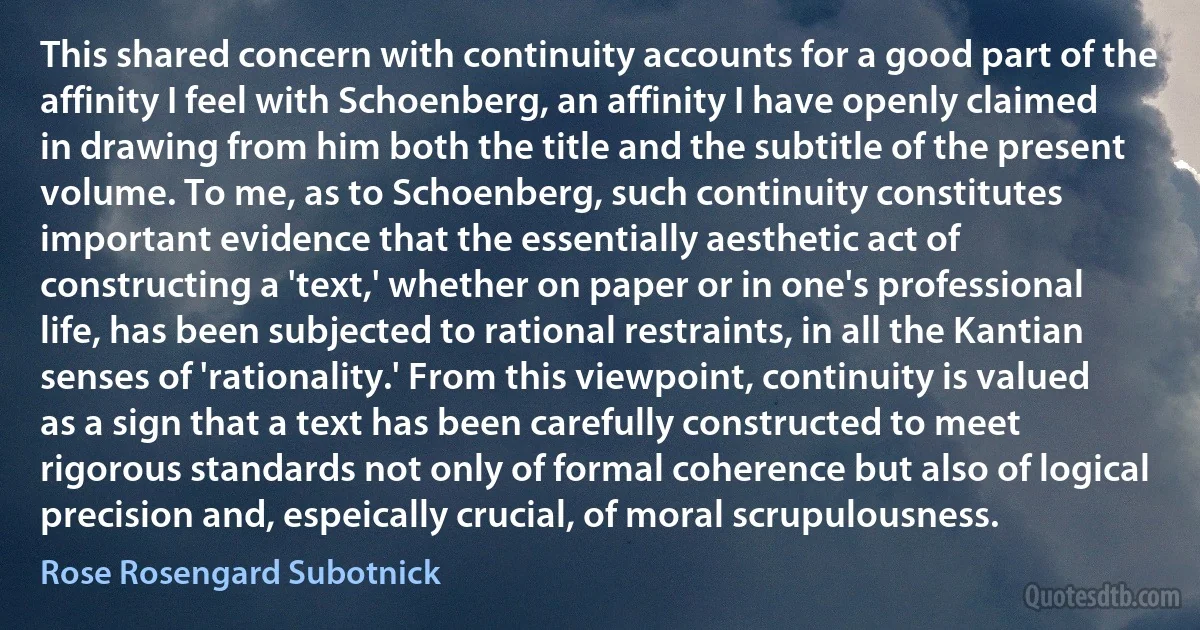
This shared concern with continuity accounts for a good part of the affinity I feel with Schoenberg, an affinity I have openly claimed in drawing from him both the title and the subtitle of the present volume. To me, as to Schoenberg, such continuity constitutes important evidence that the essentially aesthetic act of constructing a 'text,' whether on paper or in one's professional life, has been subjected to rational restraints, in all the Kantian senses of 'rationality.' From this viewpoint, continuity is valued as a sign that a text has been carefully constructed to meet rigorous standards not only of formal coherence but also of logical precision and, espeically crucial, of moral scrupulousness.
Rose Rosengard SubotnickRelated topics
act aesthetic coherence constructing continuity formal good kantian life meet paper precision present professional sign text Schoenberg viewpointRelated quotes
Some professor of history wrote that cultures define their gods when they're young and primitive, when their main concern is survival. They endow their gods with survival characteristics like omnipotence and authoritarianism, belligerence and suspicion, and that's what goes into all their myths or scriptures. Then, if they survive long enough, they begin to develop morality. They examine their own history, and they learn that authoritarianism doesn't accord with free will, that belligerence and suspicion are unhealthful, but this newly moral culture is stuck with its bigoted, interfering gods, plus it's stuck with people who prefer the old bloody gods and use them as their justification for doing all kinds of awful things.

Sheri S. Tepper
On Saturday, the 24th January, 1680/2nd Muharram, the Emperor went to view lake Udaisagar, constructed by the Rana, and ordered all the three temples on its banks to be demolished.'...On the 29th January [1680]/7th Muharram, Hasan 'Ali Khan brought to the Emperor twenty camel-loads of tents and other things captured from the Rana's palace and reported that one hundred and seventy-two other temples in the environs of Udaipur had been destroyed. The Khan received the title of Bahadur 'Alamgirshahi'...'Abu Turab, who had been sent to demolish the temples of Amber, returned to Court on Tuesday, the 10th August [1680]/24th Rajab, and reported that he had pulled down sixty-six temples.

Aurangzeb
As a mathematical object, the constitution is maximally simple, consistent, necessarily incomplete, and interpretable as a model of natural law. Political authority is allocated solely to serve the constitution. There are no authorities which are not overseen, within nonlinear structures. Constitutional language is formally constructed to eliminate all ambiguity and to be processed algorithmically. Democratic elements, along with official discretion, and legal judgment, is incorporated reluctantly, minimized in principle, and gradually eliminated through incremental formal improvement. Argument defers to mathematical expertise. Politics is a disease that the constitution is designed to cure.

Nick Land
I would like evolution to join the roster of other discredited religions, like the Cargo Cult of the South Pacific. Practitioners of Cargo Cult believed that manufactured products were created by ancestral spirits, and if they imitated what they had seen the white man do, they could cause airplanes to appear out of the sky, bringing valuable cargo like radios and TVs. So they constructed "airport towers” out of bamboo and "headphones” out of coconuts and waited for the airplanes to come with the cargo. It may sound silly, but in defense of the Cargo Cult, they did not wait as long for evidence supporting their theory as the Darwinists have waited for evidence supporting theirs.

Ann Coulter
The bomb attack on the Grand Hotel early this morning was first and foremost an inhuman, undiscriminating attempt to massacre innocent unsuspecting men and women staying in Brighton for our Conservative Conference...But the bomb attack clearly signified more than this. It was an attempt not only to disrupt and terminate our Conference; It was an attempt to cripple Her Majesty's democratically-elected Government. That is the scale of the outrage in which we have all shared, and the fact that we are gathered here now-shocked, but composed and determined-is a sign not only that this attack has failed, but that all attempts to destroy democracy by terrorism will fail.

Margaret Thatcher
